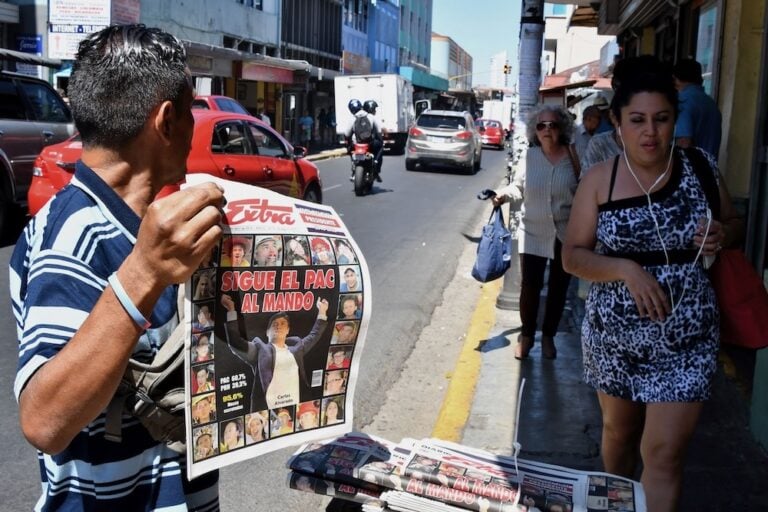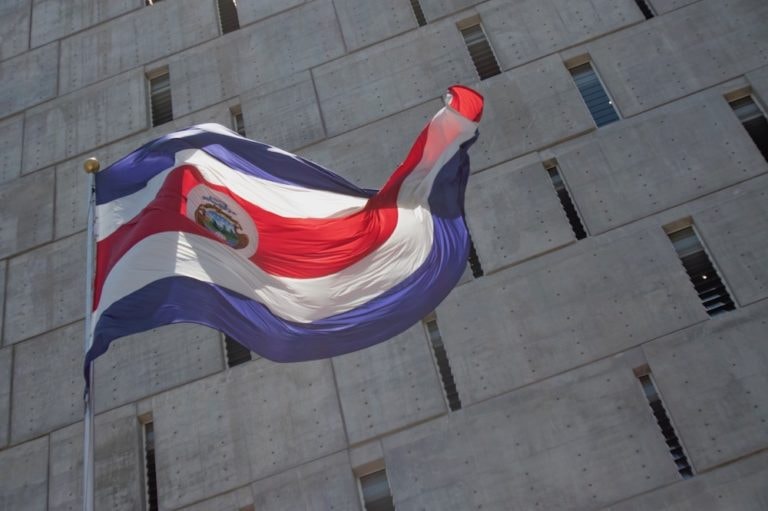(WPFC/IFEX) – The following is a 4 May 2001 WPFC press release: THE NEWSEUM OPENS COSTA RICA’S LA NACIÓN EXHIBIT IN COOPERATION WITH THE WORLD PRESS FREEDOM COMMITTEE RESTON, VA, May 4, 2001 – The Newseum today honored the extraordinary difficulties the Costa Rican media face in the form of judicial censorship by opening an […]
(WPFC/IFEX) – The following is a 4 May 2001 WPFC press release:
THE NEWSEUM OPENS COSTA RICA’S LA NACIÓN EXHIBIT IN COOPERATION WITH THE WORLD PRESS FREEDOM COMMITTEE
RESTON, VA, May 4, 2001 – The Newseum today honored the extraordinary difficulties the Costa Rican media face in the form of judicial censorship by opening an exhibit dedicated to one of the most notorious defamation sentences ever handed down in that Central American country.
The exhibit -which was put together in cooperation with the World Press Freedom Committee (WPFC)- features a copy of the Oct. 22, 1999 edition of La Nacion, Costa Rica’s largest, most influential newspaper, containing a 50,000-word Supreme Court defamation sentence in its first 12 pages.
The stern punishment stemmed from a case involving La Nacion reports about a former justice minister who was alleged to have continued using an official security detail after he left his cabinet position. The former official sued the newspaper for defamation and won. Besides the publishing of the sentence, La Nacion was ordered to pay a US$50,000 fine.
Also on Oct. 22, 1999, every Costa Rican newspaper published the same editorial denouncing the sentence as “unjustified and disproportionate” and calling it an attack against a “journalist’s right to inform and of the citizenry to be informed.”
“The exhibit the Newseum is opening today,” Eduardo Ulibarri, La Nacion news director, said, “illustrates a disturbing example of how much damage a restrictive set of laws and a senseless judiciary can inflict on freedom of expression.”
Ulibarri and La Nacion lawyer Fernando Guier attended the opening of the exhibit, which will be a permanent one and will be updated with other defamation cases the Costa Rican media are regularly hit with as a reminder that the battle for freedom of the press is far from over in that country.
Another La Nacion case is currently pending before the Inter-American Commission on Human Rights after all legal recourse was exhausted in Costa Rica. The case involves alleged dubious behavior by a Costa Rican diplomat in Europe, including bribery, corruption and criminal conduct.
The case was widely reported by European media, but after La Nacion covered the story, the reporter, Mauricio Herrera, was charged with a violation of an article of the Costa Rican criminal code which prohibits the republication of offensive statements made by others.
Finally, the Supreme Court ruled for the plaintiff and handed down the harshest defamation sentence in the country’s history, including a US$200,000 fine and the requirement that the newspaper be listed in the country’s registry of criminal offenders, alongside murderers, rapists, and counterfeiters.
“The Newseum exhibit is a victory for freedom of expression in Costa Rica,” WPFC’s Executive Director Marilyn Greene said. “But it also is a stark reminder that desacato laws, and their close cousins, slander and defamation laws, are a threat not only in Costa Rica but in the entire Latin American region. The WPFC calls again for the elimination of these laws throughout the world.”
The World Press Freedom Committee is an international umbrella organization with headquarters in Reston, USA, that includes 44 journalistic groups united in the defense and promotion of press freedom. Its activities include financial and legal assistance to journalists who suffer prosecution for censorship reasons; implementation of joint activities with the Coordinating Committee of Press Freedom Organizations, an affiliation of nine major world free-press organizations; and monitoring the respect for freedom of expression in Latin America and throughout the world.


